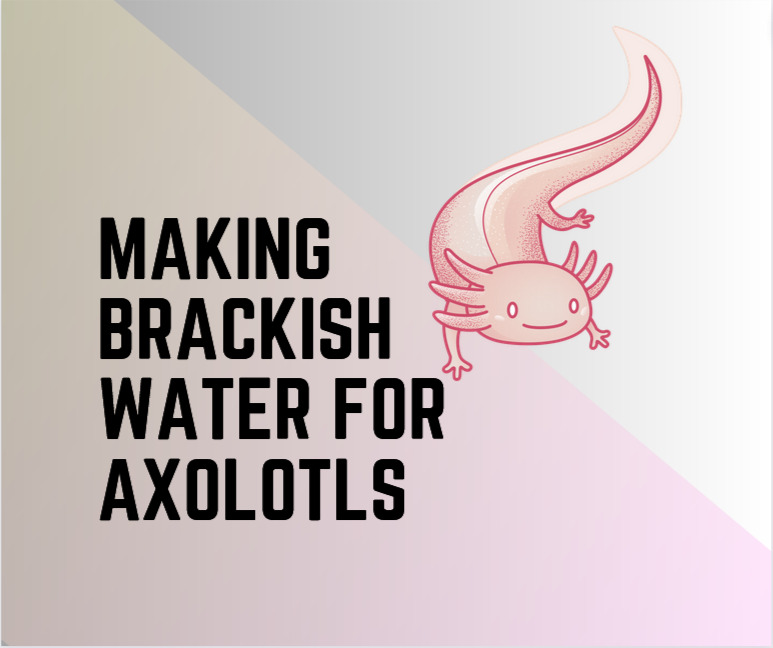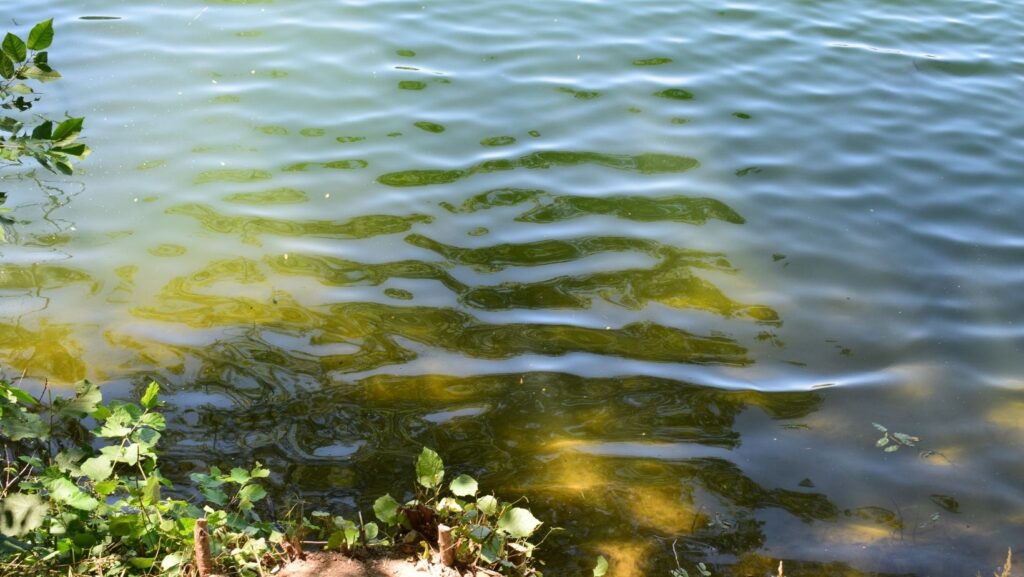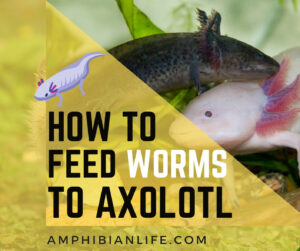
For those who are fascinated by the peculiar charm of Axolotls, this article is for you. These unique amphibians are a popular choice amongst pet enthusiasts. But do you know for housing Axolotls, creating a suitable aquatic environment is essential? These unique amphibians thrive in freshwater in their natural habitat in the wild. However, some Axolotls have adapted to living in Brackish water under certain circumstances. In fact, brackish water can benefit Axolotls in many ways. Join us in this article serves as we dive into the understanding and implementation of the process of creating brackish water habitats.
Axolotls are native to the ancient lakes and interconnected canals of Mexico. They are a type of Salamander that has captured the attention of scientists and pet enthusiasts alike. While freshwater is their natural environment, some of them may require brackish water to address specific health concerns. For keeping Axolotls as pets, creating brackish water conditions involves maintaining the delicate balance between freshwater and marine environments.
Here’s more about the same.
What is Brackish Water?
Brackish water is water that, in terms of salinity, falls somewhere between freshwater and saltwater. It is basically a mixture of freshwater and seawater with a moderate level of salt content. However, freshwater has a low salt concentration, and saltwater has a high salt concentration, but brackish water contains a lesser amount of dissolved salts.
Brackish water’s salinity typically ranges from 3,000-10,000 Mg/L TDS. However, the salinity of brackish water can vary depending on the specific location. Salinity level basically means the salt content, which creates a unique atmosphere with its own set of characteristics influencing which organisms can thrive within.
Brackish water habitats are found in estuaries, mangrove swamps, salt marshes, and certain coastal areas. Mexico is home to several brackish water habitats where axolotls thrive. These environments support a diverse range of plant and animal species that are adapted to the fluctuating freshwater and saltwater conditions.
In the context of axolotls, brackish water helps in addressing specific health conditions. It is specially used to induce breeding behavior.
What Kind of Salt Do You Need to Make Brackish Water?
Blackish water has salt but not all types of salt can make Brackish water. Only a specially formulated Marine salt can contribute to creating brackish conditions. Using a salt mix explicitly labeled for brackish water is very important.
One must read the product descriptions and instructions when selecting a salt mix. Doing so is crucial to ensure that it is suitable for brackish water setups. The marine salt packaging should specify the salinity range for which it is intended. The range typically falls from 0.5 to 30 parts per thousand (ppt).
How to Make Brackish Water for Axolotls?
Making brackish water for axolotls involves a careful process. Knowing all the ‘How’ will help you achieve the desired salinity levels.

Step-wise guide on making brackish water
- Firstly, collect all the necessary supplies, including a clean container/ aquarium, a hydrometer/ refractometer to measure salinity, a water de-chlorinator, and marine salt designed for making water brackish. You won’t need a water de-chlorinator if you already have chlorine-free water.
- Now fill the container with fresh water and make sure it is chlorine free. You can also use a de-chlorinator in order to remove any harmful chemicals or additives.
- Next, gradually add the marine salt mix to the freshwater. Ideally, 2 tablespoons of Marine Salt per gallon of water is sufficient, but following the manufacturer’s instructions is necessary. Doing so will help you achieve the desired salinity level. Add marine salt gradually and in increments. Let the salt dissolve, and the water adjusts before you add the entire required amount.
- Further, using a hydrometer or refractometer, measure water salinity. Aim for 3,000-10,000 Mg/L TDS/ a salinity level between 0.5 and 30 parts per thousand (ppt). Adjust the salt content by adding more salt or freshwater before you reach the desired goal.
- Lastly, monitor temperature and other parameters. The idea here is to make sure that water temperature remains within 18-20°C suitable for Axolotls. Make sure you perform regular tests and maintain appropriate pH and ammonia levels as well.
Transitioning Axolotls to Brackish Water
Transitioning axolotls to brackish water is a gradual process. Acclimatizing them to the changing salinity levels is important for their health and overall well-being.
Here is the step-by-step guide to transitioning axolotls to brackish water:
- Firstly, make sure that your pet axolotls require brackish water. Remember, axolotls are naturally freshwater amphibians, and not all of them need brackish conditions. It is better to do some research on your end and consult a veterinarian or an Axolotl expert to identify the situations. Some experts may suggest brackish for your Axolotls, especially for breeding or specific health conditions.
- Next, prepare a separate container/ aquarium of Brackish water for this transition. The container should be clean and must have filtration, heating, and appropriate hiding spots.
- Now place the axolotls in a separate container that has fresh water. Introduce a small amount of brackish water into their new container. Repeat this process daily and gradually increase the ratio of brackish water to freshwater over days and weeks. During the transitioning phase, keep an eye on your axolotls’ behavior and health. Upon observing any signs of stress or discomfort, slow-turn the transition. Or if their behavior, appetite, and overall well-being is impacted adversely, return the Axolotls to freshwater. For more concerns, seek advice from experts or a veterinarian.
- Once your pet axolotls have fully adapted to the brackish water conditions, you can transfer them to a brackish water aquarium. However, make sure you are still monitoring water parameters and maintaining appropriate salinity levels.
Benefits of Brackish Water for Axolotls or Other Aquatics
Brackish water has a range of benefits for axolotls and other aquatic organisms. Here are some potentials amongst the lot:
- Brackish water is therapeutically for certain health conditions in axolotls. It can support treating external parasites and bacterial infections and promoting the healing of wounds. The salinity level in brackish water has antiparasitic and antibacterial properties that improve axolotls’ overall health.
- Transitioning axolotls to brackish water can also fasten the breeding behavior. The changes in water conditions basically mimic the natural environment of Axolotls during the breeding season. It will also encourage courtship, mating, and successful reproduction.
- Brackish water offers a novel and stimulating environment for axolotls. It brings in sensory experiences like water chemistry and salinity. It will enhance Axolotl’s overall well-being and mental stimulation.
- Certain axolotl species inhabit brackish water habitats in the wild as well. Therefore transitioning them to brackish water will give birth to a more naturalistic environment for them. It will replicate their native conditions, benefiting their overall health and behavior.
- Besides Axolotls, Brackish water is suitable for other aquatic species as well. A brackish water setup also helps when you are housing axolotls alongside other compatible species. It also aids in increasing the diversity and visual appeal of the aquarium.
Water Quality for Axolotls
The best water for axolotls is freshwater that is clean, free from contaminants, and has the appropriate temperature, pH, and water parameters. Axolotls are freshwater amphibians that require specific water conditions to thrive. They are sensitive to changes in water quality, temperature, and chemistry, so it is important to maintain a stable and suitable environment for them.
Water temperature: The ideal water temperature for axolotls is between 60-68°F (16-20°C). Axolotls are sensitive to high temperatures, and exposure to temperatures above 72°F (22°C) for prolonged periods can cause stress, illness, and even death.
Water pH: The pH of the water should be between 6.5-7.5. A pH level outside this range can cause stress, illness, and death in axolotls. A pH that is too acidic can damage their skin, while a pH that is too alkaline can interfere with their ability to absorb essential nutrients.
Water parameters: Axolotls require good water circulation and aeration, as stagnant water can lead to bacterial and fungal infections. Water quality should be regularly tested and maintained to ensure proper levels of ammonia, nitrite, and nitrate. High levels of these compounds can lead to stress, illness, and even death.
Water source: The water source for axolotls should be free from contaminants such as chlorine and heavy metals. Tap water can be used, but it should be treated with a dechlorinator and allowed to sit for 24 hours before adding it to the tank. It is also recommended to use a water conditioner that removes heavy metals.
Freshwater Vs Brackish Water for Axolotls
Axolotls are freshwater amphibians that are native to Mexico. They are unique creatures that are capable of regenerating lost body parts, and they require specific water conditions to thrive. In this article, we will compare freshwater versus brackish water for axolotls to determine which is the best water for them.
Freshwater:
Axolotls are freshwater creatures, which means they require clean, fresh water to thrive. The ideal water temperature for axolotls is between 60-68°F (16-20°C), and the pH should be between 6.5-7.5. Axolotls also require good water circulation and aeration, as stagnant water can lead to bacterial and fungal infections.
Pros:
- Axolotls are adapted to freshwater and will be most comfortable in it.
- Freshwater is easier and less expensive to maintain than brackish water.
- Most common plants used in axolotl tanks are freshwater plants, making it easier to provide them with a natural habitat.
Cons:
- Freshwater may not provide the necessary minerals and trace elements found in brackish water.
- Axolotls may not be able to tolerate sudden changes in pH or temperature.
Brackish water:
Brackish water is water that is partially salty and partially freshwater. It is commonly used for marine animals that are adapted to living in estuaries or tidal zones. For axolotls, brackish water is not necessary, but some owners choose to add a small amount of aquarium salt to their water to help prevent diseases and promote healthy gill function.
Pros:
- Brackish water can provide axolotls with necessary minerals and trace elements that they may not get in freshwater.
- The addition of aquarium salt can help prevent diseases and promote healthy gill function.
Cons:
- Axolotls are not adapted to brackish water and may become stressed in it.
- Brackish water requires more monitoring and maintenance than freshwater.
Comparison Table:
| Freshwater | Brackish Water |
|---|---|
| Axolotls are adapted to freshwater | Axolotls are not adapted to brackish water |
| Easier and less expensive to maintain | Requires more monitoring and maintenance |
| Most common plants used in axolotl tanks are freshwater plants | May provide necessary minerals and trace elements |
| May not provide necessary minerals and trace elements | Axolotls may become stressed in brackish water |
Conclusion
However, one should remember that not all axolotls require or thrive in brackish water. These amphibians are primarily freshwater animals, and it is enough for them to thrive healthily. It is under certain health and breeding conditions that transitioning them to brackish water should be done. However, with careful consideration, specific goals in mind, and expert guidance.
We hope that the above method of making Brackish water for Axolotls will help you. However, we would recommend you talk with an expert instead of just going after information on the Internet.

Hi, I’m Mike, and I’m the creator of amphibianlife.com. If there was one word to describe it? It would be: passionate about Amphibians! Whether you want to know more about amphibians or have a presentation to give at school, you’ve come to the right place.




![How To Sex An Axolotl [Breeding Axolotls Male and Female]](https://www.amphibianlife.com/wp-content/uploads/2023/05/How-To-Sex-An-Axolotl-300x251.jpg)


